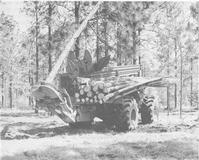


Chapter 4
I Management Of Native Forests
II Plantations-high Productivity Resources
III Protecting The Resource
IV Harvesting The Resource
V Solid Wood And Its Processing
VI Minor Forest Products
VII Reconstituted Wood Products
VIII Pulp And Paper
IX Export Woodchips
X Future Directions
XI Acknowledgements
References
Index
Search
Help
Contact us

The development of the bulldozer from the crawler-tractor proved to be beneficial in logging as well as in road-making, as it facilitated access to the trees to be felled as well as their extraction. It also enabled undergrowth and logging waste to be cleared and stacked, for burning where appropriate in order to promote regeneration.
The wood pulp industry, which started in Tasmania and Victoria in the late 1930s, brought new harvesting requirements. Initially it used mainly large mature or overmature eucalypts from which billets of smaller cross-section had to be cut for feeding its chippers or grinders. This was done either at the pulp mill by breaking down the logs in a conventional sawmill operation -and sometimes also producing sawn timber from better quality logs as a by-product -or in the forest by cutting the logs to billet length and splitting them. The latter method was generally used for overmature trees, as these were of little value as sawn timber. Originally splitting was done by wedge and mallet, a method also once used by small sawmillers to reduce large logs to a size which they could handle. Later, splitting 'guns' were introduced and since the 1960s the use of a splitting wedge mounted on a bulldozer blade. At some locations hydraulic or steam splitters were also used.
Because the wood pulp industry did not have the same wood quality requirements as the sawmilling industry it provided new opportunities for more efficient utilization of the native forest resources and for their improvement. As well as pulp mills recovering saleable sawn timber from the logs that they processed to billets the converse began to be introduced in the 1950s, when sawmillers began to instal chippers to make chips for sale to the pulp mills from wood that they had harvested but which was either not of sawn timber quality or obtained as waste edgings and offcuts from the sawing operation.
In the 1950s and 60s the industry started to experience a major shift towards the harvesting of smaller logs. Not only were increasing quantities of thinnings harvested from native forests for the wood pulp industry but there was also a progressive fall in saw log diameter because of the decreasing availability of mature trees. Moreover, more and more wood was becoming available from the pine plantations, both as thinnings and saw logs.
In the early 1960s new harvesting technology began to be developed overseas for smaller diameter trees, the main trends being towards greater labour productivity, reduced tree damage and less soil disturbance and compaction. These were achieved by the use of versatile and highly mobile and manoeuvrable vehicles of low ground pressure, such as wheeled skidders and forwarders. In 1959 a Harvesting Section was established in the Forestry and Timber Bureau and as well as developing its own concepts it imported some of this new technology for demonstration to the local industry. Among its own developments were a widely-used tracked front-end loader fitted with loading forks and a logging arch for large eucalypt log extraction and, in 1970, a harvester for plantation pine thinnings, before such units were readily available overseas. Known as the Windsor Harvester[45] after the local company R. L. Windsor Pty. Ltd. with whom it was developed, it was used commercially both in Australia and Canada. While only three units were made and used here, some fifty units were made under licence in Canada.

Organisations in Australian Science at Work - Forestry and Timber Bureau; R. L. Windsor Pty Ltd
 |
Australian Academy of Technological Sciences and Engineering |  |
© 1988 Print Edition pages 213 - 214, Online Edition 2000
Published by Australian Science and Technology Heritage Centre, using the Web Academic Resource Publisher
http://www.austehc.unimelb.edu.au/tia/223.html